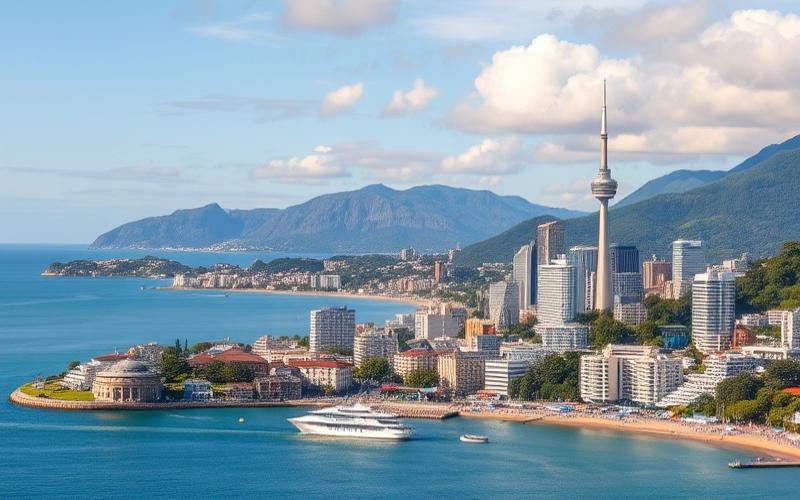
 Published on and written by Cyril Jarnias
Published on and written by Cyril Jarnias
Renovating a Property in New Zealand: A Rewarding Adventure
Renovating a property in New Zealand can be an exciting adventure, both rich in challenges and full of unique opportunities. With a constantly evolving real estate market and strong demand for sustainable, eco-friendly housing, a well-planned renovation project can not only increase your property’s value but also transform an ordinary space into a true modern sanctuary.
Keys to a Successful Renovation
From selecting local materials to crucial financing steps and compliance with current regulations, every aspect of the renovation must be carefully considered.
New Zealand Specifics
This article will guide you through the essential steps to successfully complete your project, while emphasizing the cultural and architectural particularities that distinguish New Zealand in the global real estate landscape.
Good to Know:
New Zealand has specific building standards adapted to its unique environment, including strict seismic regulations and thermal insulation recommendations.
Enhancing Your Property Value in New Zealand
The New Zealand real estate market is experiencing a moderate recovery in 2025, with expected national value increases of around 3.8 to 6%, and sales volume rising by 10 to 15%. In this context, enhancing your property’s value requires integrating emerging trends and the specific expectations of the local market.
Strategies to Increase Property Value:
Eco-Friendly Renovation:
- Installation of solar panels
- Enhanced insulation with eco-friendly materials (natural wool, double/triple glazing)
- Rainwater harvesting systems
- Heat pump or high-efficiency balanced ventilation systems
Aesthetic and Functional Modernization:
- Open kitchens with energy-efficient appliances
- Contemporary bathrooms (low-flow fixtures, walk-in showers)
- Modern finishes (FSC-certified durable hardwood, zero-VOC paints)
Outdoor Space Optimization:
- Creating or renovating a deck with recyclable composite wood
- Landscaping incorporating native, low-water plants
- Covered barbecue or outdoor lounge areas
Creating Open Spaces (“Open Plan Living”):
Buyers now prefer spacious living areas that combine kitchen, dining, and living rooms for greater sociability.
Concrete Examples & Quantified Impact:
| Type of Improvement | Estimated Value Added | Recent New Zealand Examples |
|---|---|---|
| Renovated/Open Plan Kitchen | +5% to +10% | Auckland Residential Areas |
| Modernized Bathroom | +3% to +7% | Wellington Suburbs |
| Solar Panel Installation | Up to +4% | Christchurch |
| Complete Eco-Insulation | Up to +6% | Hamilton |
| Premium Outdoor Landscaping | +2% to +8% | Tauranga |
Recent Statistics:
- A study of New Zealand buyers indicates that over 60% now prioritize “eco-friendly” properties in their final choice.
- Homes that have undergone energy-efficient renovations sell on average twice as fast in the urban market.
- The projected national average annual rate for real estate growth is estimated between 4.3% and 6% until 2027.
Eco-friendly improvements align with a deep trend supported by the New Zealand government, which fiscally encourages these investments. Modernizing your property along these lines not only provides immediate value enhancement but also ensures lasting appeal to future buyers.
Good to Know:
To enhance your property value in New Zealand, it’s crucial to follow current market trends that value eco-friendly renovations by integrating sustainable technologies and eco-responsible materials; these elements can also attract environmentally conscious buyers. Additionally, modernizing kitchens and bathrooms, optimizing outdoor spaces with landscaped gardens, or creating open living areas aligns with contemporary buyer preferences, thereby increasing your property’s appeal and value. According to a 2023 report, renovations, particularly eco-friendly ones, can increase residential value by up to 20%, with eco-renovated properties selling on average 10% faster than others.
Key Steps for a Successful Renovation
Key Steps to Successfully Renovate a Property in New Zealand
1. Planning
- Define the project objectives precisely.
- Develop a realistic budget, including a contingency for unexpected costs.
- Establish a timeline with clear deadlines for each phase.
2. Local Regulations and Compliance
- Research the applicable planning and building rules according to the region or city.
- Check if the project requires a building consent (mandatory for any structural modification, addition of a bathroom, kitchenette, or change of space usage).
- Ensure all renovations comply with the New Zealand Building Code to avoid fines, demolition, or issues with home insurance.
3. Research and Selection of Qualified Professionals
- Identify necessary architects, contractors, and tradespeople based on the project’s scale.
- Request multiple detailed quotes.
- Systematically check professional references, certifications (Licensed Building Practitioner), and experience with similar projects.
4. Obtaining Necessary Permits
| Process | Description |
|---|---|
| Preliminary Consultation | Schedule a meeting with the local council to present the project |
| Application Submission | Submit detailed architectural plans + required documents |
| Waiting & Follow-up | Allow several weeks/months depending on complexity |
| Inspection & Compliance | Host inspectors during various stages |
5. Logistics: Material Management & Delivery Timelines
- List all necessary materials during the planning phase.
- Order in advance from reliable suppliers; anticipate potential supply delays (especially in some remote regions).
- Organize secure on-site storage.
6. Site Monitoring & Communication
Practical Tips:
- Maintain regular contact with all stakeholders (weekly meetings recommended).
- Document each stage in writing: work progress, any incidents, budget or schedule adjustments.
- Ensure all modifications remain compliant with local standards before final execution.
Checklist
- Plan: clear objectives + budget + realistic timeline
- Check local regulations
- Select qualified professionals
- Obtain mandatory permits before any start
- Manage material logistics/delays
- Ensure strict monitoring and transparent communication
Rigorous management at each stage ensures not only a successful renovation but also the lasting enhancement of your property value in New Zealand.
Good to Know:
To succeed in a renovation in New Zealand, start with rigorous planning by defining a realistic budget and timeline. Ensure you understand and comply with local building and planning regulations, checking the specific requirements of your municipality. Engage qualified professionals, such as architects and contractors, by meticulously verifying their references and certifications. Do not neglect the process for obtaining necessary permits, which can be complex and time-consuming. Also plan logistics, including material management and delivery timelines to avoid costly delays. Finally, closely monitor the project and communicate regularly with all stakeholders to ensure a smooth renovation that complies with local standards.
Optimizing Your Budget and Financing Your Project
Strategies for Establishing a Realistic Renovation Budget in New Zealand
- Accurately assess the size, initial condition, and needs of the home.
- Consult multiple local professionals to obtain detailed quotes (labor, materials, project management).
- Consider location: costs are generally higher in major cities than in rural areas.
Typical Renovation Costs (2025)
| Project Type | Approximate Cost (NZD) |
|---|---|
| Roof Replacement | 14,000 |
| Kitchen Renovation | 35,000 |
| Bathroom (Mid-Range) | 25,000 |
| Exterior Cladding | 35,000 |
| Exterior Painting | 10,000 |
| Double Glazing | 10,000 |
| Ventilation System | 5,000 |
For a Full Renovation:
| House Size | Basic | Mid-Range | High-End |
|---|---|---|---|
| Small (100-130m²) | $95k-$150k | $150k-$250k | $250k-$400k+ |
| Medium (140-190m²) | $140k-$220k | $220k-$350k | $350k-$550k+ |
Architect, permit, and structural engineering fees are additional to these amounts. Also budget for temporary relocation if necessary.
Required Permits
- Mandatory submission to the local council for all structural work or major modifications.
- Fees vary depending on the project scale. They are often not included in builder or tradesperson quotes.
Available Financing Options
List of Main Solutions:
- Bank Mortgage Loan: extension of existing loan or new mortgage with post-renovation valuation.
- Consumer Credit: suitable for small projects but with higher interest rates.
- Specific Grants: some local assistance targets energy performance or thermal improvement; inquire with the council and on the Energywise NZ website.
Quick Comparison Table:
| Option | Advantages | Disadvantages |
|---|---|---|
| Mortgage Loan | Low rates, high amounts | Lengthy process |
| Consumer Credit | Quick procedures | Higher rates |
| Energy & Eco Grant | Partial assistance |
Planning for Financial Contingencies
It is advisable to add an additional buffer of 10% to 20% to the total budget to anticipate:
- Unexpected discoveries during work
- Raw material price increases
- Delays related to administrative approvals
To effectively manage these uncertainties:
- Secure a dedicated fund for these unexpected expenses from the start
- Maintain regular communication with contractors/project manager
Tips to Save Without Sacrificing Quality
- Use local materials as much as possible to reduce transport costs
- Compare multiple quotes before each major order
- Prioritize essential renovations; postpone those that can wait
- Reuse certain existing elements if they are still functional
Useful Local Resources
Non-Exhaustive List:
- Official sites like Building.govt.nz to know applicable standards/permits
- Municipal advisors specialized in sustainable housing (“Eco Design Advisors”)
- Comparison platforms such as BuilderConnect.co.nz or YasenConstruction.co.nz
Proper budget planning not only avoids financial stress but also ensures a final result that meets your expectations while complying with New Zealand legislation.
Good to Know:
To optimize your renovation budget in New Zealand, start by establishing a realistic budget that includes the costs of local materials, often more economical, as well as labor costs, which are generally high. Don’t forget to include fees for necessary permits. For financing, explore traditional bank loans, consumer credit, and seek grants specifically dedicated to property renovation. Consider allocating about 10 to 20% of your total budget to contingencies, such as structural discoveries or material cost increases. To save, consider bulk purchasing of materials or use local resources, such as New Zealand online platforms, which often offer materials at reduced prices. Also consider local tradespeople for labor savings, while investing in the quality of your renovation.
Selecting the Best Materials for Your Renovation
New Zealand’s primarily oceanic climate features low annual temperature variations (from 8°C in the south to 16°C in the north), but rapid weather changes and significant exposure to prevailing westerly winds. The mountainous topography divides the country into very contrasting zones: the west coast of the South Island is very humid while eastern areas are drier. Winters are generally mild on the coast but can be harsh in the Southern Alps. Annual sunshine is high (over 2000 hours) and UV radiation frequently reaches extreme indices.
These conditions require renovation materials to be resistant to moisture, thermal variations, and UV. The choice must also account for the increased risk of coastal flooding and intense rainfall episodes.
Sustainable and Eco-Friendly Materials Available Locally:
- FSC-certified native timber (recycled kauri, rimu)
- Treated radiata pine from local plantations
- Low-carbon concrete with local aggregates
- Regionally produced terracotta bricks
- Natural insulators: New Zealand sheep’s wool, plant-based fiber panels
- Exterior cladding in composite wood or recycled galvanized steel
Local Regulations and Standards:
New Zealand applies the New Zealand Building Code (NZBC), which mandates:
- Structural resilience adapted to high seismic risk;
- Enhanced protection against moisture to prevent mold;
- Strict requirements on thermal performance (minimum R-values for walls/roofs);
- Tax incentives for using certified eco-friendly materials.
Associated Costs by Main Types:
| Material | Initial Cost | Durability | Maintenance |
|---|---|---|---|
| Recycled Native Timber | High | Very High | Medium |
| Treated Radiata Pine | Moderate | Medium | Low |
| Low-Carbon Concrete | Moderate/High | Very High | Low |
| Local Terracotta Bricks | High | Very High | Low |
| Galvanized Steel | Moderate/High | High | Low |
Tips for Choosing Between Materials:
- Durability: Prioritize those that resist moisture, salt spray near coasts, and UV well.
- Energy Efficiency: Opt for good natural insulation; local wool or high-performance double glazing.
- Aesthetics: Integrate finishes harmoniously with the local architectural style.
- Total Cost: Compare not only the initial price but also the expected lifespan and maintenance costs.
Popular Materials Among Local Contractors:
Brick, local treated wood, galvanized steel for roofing/facades; wool insulation from the New Zealand sheep sector; eco-paints suited to humid climates.
Concrete Examples:
“A renovated Victorian villa in Auckland used a mixed wood/steel recyclable cladding that perfectly resisted heavy rain while maintaining a traditional appearance.”
“In a recent project in Queenstown, local wool insulation coupled with high-performance glazing significantly reduced winter energy needs despite a cold alpine climate.”
In summary: selecting materials requires integrating local climatic constraints, regional availability, ecological performance, and strict compliance with the NZBC to ensure structural safety, lasting comfort, and low environmental impact.
Good to Know:
In New Zealand, varied climatic conditions, ranging from storms in the North to alpine climate in the South, strongly influence the choice of materials for renovations. Sustainable and eco-friendly materials such as FSC-certified wood, recycled concrete, or low-carbon footprint steel are recommended for their weather resistance and compliance with New Zealand building standards. It is crucial to respect local regulations, which emphasize energy efficiency and durability. Costs vary, with local materials often being more affordable and better suited to the climate. For example, the combined use of sheep’s wool for insulation and solar panels ensures optimal energy performance. Local contractors also favor native timber, such as rimu or kauri, for their aesthetics and proven durability in many successful projects. When choosing between materials, consider not only the cost but also their environmental impact and long-term durability to succeed in your renovation while respecting local standards and style.
Disclaimer: The information provided on this website is for informational purposes only and does not constitute financial, legal, or professional advice. We encourage you to consult qualified experts before making any investment, real estate, or expatriation decisions. Although we strive to maintain up-to-date and accurate information, we do not guarantee the completeness, accuracy, or timeliness of the proposed content. As investment and expatriation involve risks, we disclaim any liability for potential losses or damages arising from the use of this site. Your use of this site confirms your acceptance of these terms and your understanding of the associated risks.














































